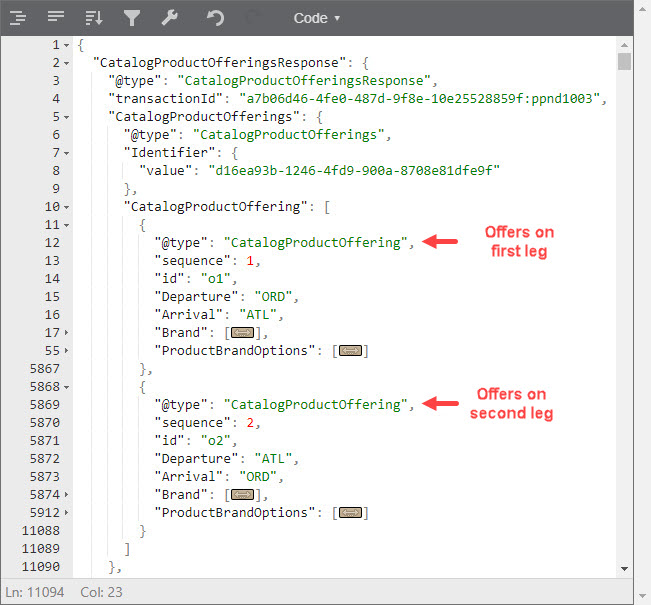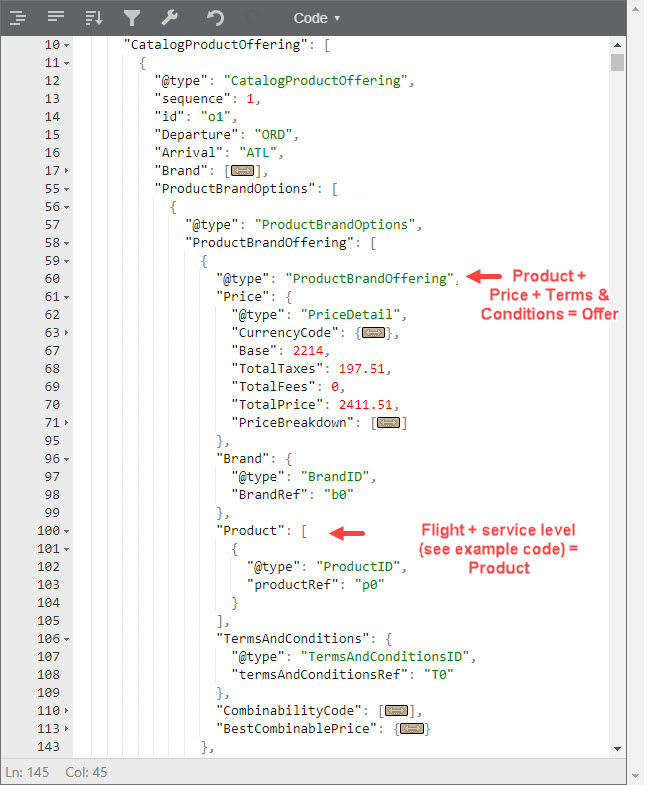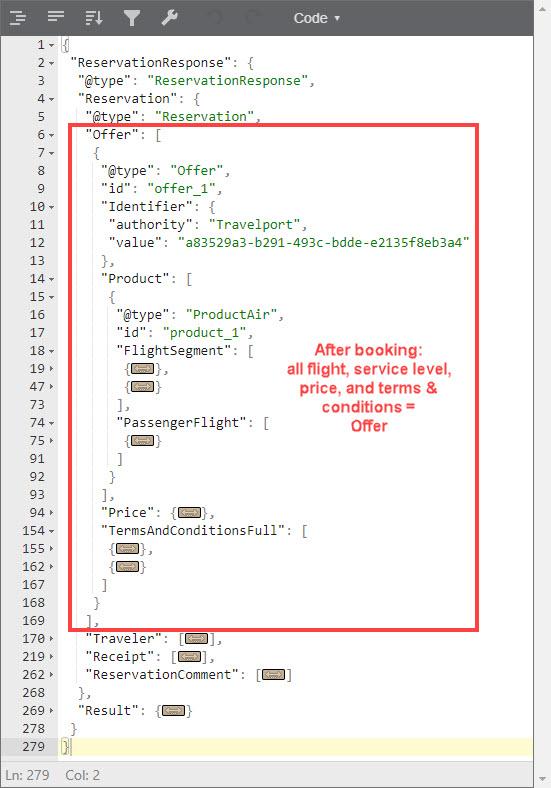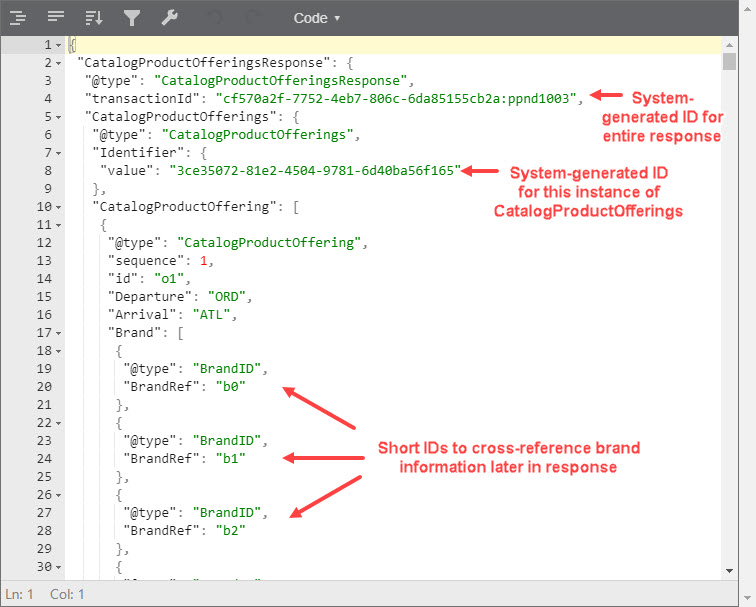JSON Air APIs Guide
This guide provides a general introduction to using the JSON APIs to search for and book air travel. It discusses basic travel terms you need to know to develop your applications and how those terms are represented in the JSON responses. It also summarizes the general workflow from searching for flights through ticketing.
The terms and concepts in this guide are essential to understanding travel development for all the JSON Air APIs.
In this guide:
- Basic Concepts
- Offers in the JSON APIs
- Reference Payload and Full Payload Request Formats
- Identifiers in the JSON APIs
- GDS and NDC Content
- JSON APIs List by Functional Area
- JSON API End-to-End Workflows
Basic Concepts
First let's look at terms used across the travel industry. These help you understand the request and response structure of all JSON APIs.
PTCs, Service Levels, Branded Fares
The Travelport Search APIs support any of the following types of itineraries. An itinerary is the entire trip a traveler wants to book.
- One way: Trip to a single destination; e.g., LHR > CDG.
- Round trip: Trip to a single destination and back to the original point of departure; e.g., LHR > CDG and CDG > LHR
- Multi-city: Trip to multiple destinations; e.g., LHR > CDG > AMS > BCN.
- Open-jaw: Trip to one destination and a return from another city; e.g., LHR > CDG and AMS > LHR.
The airline industry categorizes travelers under various passenger type codes (PTCs). The most common PTCs are Adult (ADT), Child (CNN), and Infant (INF). You can request a maximum of nine passengers in one air search.
An airfare with certain features included in the price is a branded fare. For example, a branded fare may include a seat assignment choice and wifi at no extra charge. An upsell is a fare presented along with the base fare as a higher level of service, and is usually a branded fare. Upsell to a higher brand is an integral part of branding. Branded fares and upsells are detailed in the Air Shopping Guide.
Airlines provide different service levels, grouping services into cabin classes. The following are standard cabin classes:
- Economy: Travelers receive standard services with no perks. Identified by cabin class code Y or the word COACH.
- Premium Economy: Travelers receive a better seating preference than Economy class. Identified by cabin class code W.
- Business: Travelers receive more service than economy but fewer than First. Identified by cabin class code C.
- First: Travelers receive upgraded service; the most expensive fares. Identified by cabin class code F.
Itinerary, Leg, Segment
Next, let's look at the parts of an itinerary, sometimes called a journey.
To illustrate let's use an example round-trip booking from LAX>MSP: The trip starts with a direct flight from LAX>MSP. The return has a change of planes in DEN, so MSP>DEN>LAX.
In our example, the itinerary includes everything: LAX>MSP and MSP>DEN>LAX.
A leg is the part of the itinerary from one origin to one destination. A leg is also called an origin and destination (O&D) pair.
Our example has two legs:
LAX>MSP is the first leg, also called the outbound leg.
MSP>DEN>LAX is the second leg, also called the return or inbound leg.
A segment is one single flight on a leg.
In our example, the first leg has one segment (LAX>MSP). The return leg has two segments (MSP>DEN and DEN>LAX) because there is a change of plane.
Offers in the JSON APIs
Now let's look at how these terms are represented in the actual JSON code used to request and return air travel.
Here's the basic workflow for travel booking, described later in Workflow Summary:
-
Search: Enter itinerary details and shop for flights.
-
Price: Confirm pricing on flights (optional in some cases; required for NDC and some low-cost carriers).
-
Book: A workflow of linked API calls to establish a workbench session, add an offer
 In the JSON Search APIs, an offer is a product available at a specific price under a set of terms and conditions. An offer includes the flight or connecting flights for one leg of the itinerary, plus a service level that includes the cabin class and any fare codes that may apply. At booking, the selected offer from the Search response - including the flight/s, service level, price, terms and conditions, and brand if applicable - is converted into a single Offer object that is subsequently returned for that booking. and traveler data to the workbench, and commit the workbench to create a held booking, aka reservation.
In the JSON Search APIs, an offer is a product available at a specific price under a set of terms and conditions. An offer includes the flight or connecting flights for one leg of the itinerary, plus a service level that includes the cabin class and any fare codes that may apply. At booking, the selected offer from the Search response - including the flight/s, service level, price, terms and conditions, and brand if applicable - is converted into a single Offer object that is subsequently returned for that booking. and traveler data to the workbench, and commit the workbench to create a held booking, aka reservation. -
Ticket: Issue tickets for the held booking.
Offers in Search Responses
In the JSON Search APIs, the various options a customer can choose from are called offers. Offers are returned in the JSON responses through the full workflow. Starting with the JSON Search APIs, a search returns multiple offers for each leg on the itinerary, depending on availability on that route. Offers for each leg![]() The flight or connecting flights between one origin and destination pair. For example, on a round-trip flight, LAX > MSP could be the first leg (aka outbound leg) and MSP > DEN > LAX could be the second leg (aka inbound leg). The JSON APIs use the term product for one leg of the itinerary. are returned in the CatalogProductOffering object.
The flight or connecting flights between one origin and destination pair. For example, on a round-trip flight, LAX > MSP could be the first leg (aka outbound leg) and MSP > DEN > LAX could be the second leg (aka inbound leg). The JSON APIs use the term product for one leg of the itinerary. are returned in the CatalogProductOffering object.
Key point: One leg = CatalogProductOffering object
In the example below, one instance of CatalogProductOffering is the O&D pair ORD > ATL. The second instance is the return/inbound leg ATL > ORD.
The core of each offer is the product, which is the flight or connecting flights on that leg plus a service level. The service level includes the cabin class and any applicable fare codes.
Key point: Flight + service level = Product object
Each offer presents a product that's available at a specific price under a set of terms and conditions. These may include minimum stay requirements or the number of checked bags allowed. In the Search APIs, this information is combined in the ProductBrandOffering object.
Key point: Product + price + terms and conditions = ProductBrandOffering object
This concept of an offer continues throughout the JSON API booking workflow and is frequently used in this online help.
The same product may be returned in multiple offers at different price points and terms and conditions, and included in various brands. Instead of repeating all this common information in each offer, the Search APIs consolidate it in the ReferenceList object later in the response. So, each offer returns a price and cross-references to the details of its product, brand, and set of terms and conditions.
For example, product details are returned in ReferenceListProduct. The example code below shows all the information returned for one product. The product p0 provides the specific class of service, cabin class, and the fare basis code and type, and cross-references to a set of connecting flights. Flight details are returned in instances of ReferenceListFlight for s16 and s17 (not shown here).
{
"@type": "ReferenceListProduct",
"Product": [
{
"@type": "ProductAir",
"totalDuration": "PT6H13M",
"id": "p0",
"Quantity": 1,
"FlightSegment": [
{
"@type": "FlightSegment",
"sequence": 1,
"connectionDuration": "PT1H11M",
"boundFlightsInd": true,
"Flight": {
"@type": "FlightID",
"FlightRef": "s16"
}
},
{
"@type": "FlightSegment",
"sequence": 2,
"Flight": {
"@type": "FlightID",
"FlightRef": "s17"
}
}
],
"PassengerFlight": [
{
"@type": "PassengerFlight",
"passengerQuantity": 1,
"passengerTypeCode": "ADT",
"FlightProduct": [
{
"@type": "FlightProduct",
"segmentSequence": [
1,
2
],
"classOfService": "C",
"cabin": "First",
"fareBasisCode": "BAA0AFFN",
"fareType": "PublicFare",
"Brand": {
"@type": "BrandID",
"BrandRef": "b0"
}
}
]
}
]
},Offers in Booking, Ticketing, and Exchanges/Refunds
After the Search and optional price confirmation steps, book the flight/s:
-
Initiate a workbench session.
-
Send a selected offer from a Search response.
-
Send traveler details.
-
Commit the workbench to create a booking.
At that point the offer from the Search response - including the service level, price, and terms and conditions - is converted into a single Offer object. This offer data remains the same for all subsequent calls for that booking, including ticketing, modifications, and exchanges/refunds.
Key point: Product + price + terms and conditions = Offer object in Book and following transactions
The example below shows the structure of the entire Offer object after the booking commit. The single Identifer/value a83529a3-b291-493c-bdde-e2135f8eb3a4 and Offer/id offer_1 can be used from this point on to refer to that offer as a whole. In addition, the Receipt object returns a booking confirmation code, also called a locator code or PNR.
The example below shows the complete JSON code of the booking commit response.
{
"ReservationResponse": {
"@type": "ReservationResponse",
"Reservation": {
"@type": "Reservation",
"Offer": [
{
"@type": "Offer",
"id": "offer_1",
"Identifier": {
"authority": "Travelport",
"value": "a83529a3-b291-493c-bdde-e2135f8eb3a4"
},
"Product": [
{
"@type": "ProductAir",
"id": "product_1",
"FlightSegment": [
{
"@type": "FlightSegment",
"id": "FlightSegment_01",
"sequence": 1,
"connectionDuration": "PT50M",
"boundFlightsInd": true,
"Flight": {
"@type": "FlightDetail",
"duration": "PT2H22M",
"carrier": "UA",
"number": "763",
"equipment": "777",
"id": "Flight_01",
"Departure": {
"@type": "Departure",
"location": "ORD",
"date": "2023-03-03",
"time": "09:45:00"
},
"Arrival": {
"@type": "Arrival",
"location": "ATL",
"date": "2023-03-03",
"time": "13:07:00"
},
"AvailabilitySourceCode": "P"
}
},
{
"@type": "FlightSegment",
"id": "FlightSegment_02",
"sequence": 2,
"Flight": {
"@type": "FlightDetail",
"duration": "PT1H57M",
"carrier": "UA",
"number": "2290",
"equipment": "319",
"id": "Flight_02",
"Departure": {
"@type": "Departure",
"location": "ATL",
"date": "2023-03-03",
"time": "13:57:00"
},
"Arrival": {
"@type": "Arrival",
"location": "DEN",
"date": "2023-03-03",
"time": "16:54:00"
},
"AvailabilitySourceCode": "P"
}
}
],
"PassengerFlight": [
{
"@type": "PassengerFlight",
"passengerQuantity": 1,
"passengerTypeCode": "ADT",
"FlightProduct": [
{
"@type": "FlightProduct",
"segmentSequence": [
1,
2
],
"classOfService": "S",
"cabin": "Economy"
}
]
}
]
}
],
"Price": {
"@type": "PriceDetail",
"id": "PriceDetail_1",
"CurrencyCode": {
"value": "AUD"
},
"Base": 272,
"TotalTaxes": 55.3,
"TotalFees": 0,
"TotalPrice": 327.3,
"PriceBreakdown": [
{
"@type": "PriceBreakdownAir",
"quantity": 1,
"requestedPassengerType": "ADT",
"Amount": {
"@type": "Amount",
"currencySource": "Charged",
"approximateInd": true,
"CurrencyCode": {
"decimalPlace": 2,
"value": "AUD"
},
"Base": 272,
"Taxes": {
"@type": "TaxesDetail",
"TotalTaxes": 55.3,
"Tax": [
{
"currencyCode": "AUD",
"taxCode": "AY",
"value": 8.1
},
{
"currencyCode": "AUD",
"taxCode": "US",
"value": 20.4
},
{
"currencyCode": "AUD",
"taxCode": "XF",
"value": 13
},
{
"currencyCode": "AUD",
"taxCode": "ZP",
"value": 13.8
}
]
},
"Total": 327.3
},
"FiledAmount": {
"currencyCode": "USD",
"decimalPlace": 2,
"value": 189.77
}
}
]
},
"TermsAndConditionsFull": [
{
"@type": "TermsAndConditionsFullAir",
"Identifier": {
"authority": "Travelport",
"value": "cc6d639c-a1dc-4226-be71-ac3d62806d88"
}
},
{
"@type": "TermsAndConditionsFullAir",
"ExpiryDate": "2023-02-02T23:59:00Z",
"PaymentTimeLimit": "2023-02-02T23:59:00Z"
}
]
}
],
"Traveler": [
{
"@type": "Traveler",
"birthDate": "1986-11-11",
"gender": "Male",
"passengerTypeCode": "ADT",
"id": "travelerRefId_1",
"Identifier": {
"authority": "Travelport",
"value": "0d6b4ede-db45-4bfa-bdd6-68e04e795278"
},
"PersonName": {
"@type": "PersonName",
"Given": "TESTFIRST",
"Surname": "TESTLAST"
},
"Telephone": [
{
"@type": "TelephoneDetail",
"countryAccessCode": "1",
"phoneNumber": "212456121",
"id": "telephone_1",
"cityCode": "ORD",
"role": "Home"
}
],
"Email": [
{
"value": "Traveler*On*e@gmail.com"
}
],
"TravelDocument": [
{
"@type": "TravelDocumentDetail",
"docNumber": "A123123",
"docType": "Passport",
"expireDate": "2033-01-31",
"issueCountry": "US",
"birthDate": "1986-11-11",
"Gender": "Male",
"PersonName": {
"@type": "PersonName",
"Given": "TESTFIRST",
"Surname": "TESTLAST"
}
}
]
}
],
"Receipt": [
{
"@type": "ReceiptConfirmation",
"Identifier": {
"authority": "Travelport",
"value": "eccd6c3e-f9c3-428c-94e0-cf0b604d8af6"
},
"Confirmation": {
"@type": "ConfirmationHold",
"Locator": {
"source": "1G",
"value": "3HQHK3"
},
"OfferStatus": {
"@type": "OfferStatusAir",
"StatusAir": [
{
"flightRefs": [
"Flight_01",
"Flight_02"
],
"code": "HK",
"value": "Confirmed"
}
]
}
}
},
{
"@type": "ReceiptConfirmation",
"Identifier": {
"authority": "Travelport",
"value": "1738f433-7f18-4f9b-9665-cc7e804f22ba"
},
"Confirmation": {
"@type": "ConfirmationHold",
"Locator": {
"source": "UA",
"value": "IYF0MD"
}
}
}
],
"ReservationComment": [
{
"@type": "ReservationComment",
"commentSource": "Agency"
}
]
},
}
},Reference and Full Payload Requests
Using the identifiers detailed above, many of the JSON APIs allow you to send information either by referring to a previous result. Several APIs also support sending full details instead.
- Reference payload request: Sends reference identifiers from a previous response. Supported for NDC and GDS.
- Full payload request: Sends full details without a reference to any previous response. Can be used to send information returned in a previous JSON API response or from a non-Travelport source.
The JSON APIs provide support for NDC only through reference payload requests that refer to previous responses in the workflow. For this reason, full payload requests are not supported for NDC in most cases.
The examples below show a reference payload Add Offer request, and then a full payload Add Offer request. The reference payload example sends response, offer, and product identifiers from a cached, previous AirPrice response while the second, full payload example sends complete flight details.
{
"OfferQueryBuildFromCatalogProductOfferings": {
"BuildFromCatalogProductOfferingsRequest": {
"@type": "BuildFromCatalogProductOfferingsRequestAir",
"CatalogProductOfferingsIdentifier": {
"Identifier": {
"value": "1fceb004-aaca-4657-930a-cb6304fa89e2"
}
},
"CatalogProductOfferingSelection": [
{
"CatalogProductOfferingIdentifier": {
"Identifier": {
"value": "QF_CPO0"
}
},
"ProductIdentifier": [
{
"Identifier": {
"value": "QFp0"
}
}
]
},
{
"CatalogProductOfferingIdentifier": {
"Identifier": {
"value": "QF_CPO1"
}
},
"ProductIdentifier": [
{
"Identifier": {
"value": "QFp24"
}
}
]
}
]
}
}
}{
"OfferQueryBuildFromProducts": {
"BuildFromProductsRequest": {
"@type": "BuildFromProductsRequestAir",
"PassengerCriteria": [
{
"number": 1,
"age": 25,
"passengerTypeCode": "ADT"
}
],
"ProductCriteriaAir": [
{
"SpecificFlightCriteria": [
{
"flightNumber": "733",
"carrier": "QF",
"departureDate": "2022-01-09",
"departureTime": "08:35:00",
"arrivalDate": "2022-01-09",
"arrivalTime": "10:10:00",
"from": "SYD",
"to": "ADL",
"classOfService": "Q",
"cabin": "Economy",
"segmentSequence": 1,
"brandTier": "1"
},
{
"flightNumber": "680",
"carrier": "QF",
"departureDate": "2022-01-09",
"departureTime": "12:05:00",
"arrivalDate": "2022-01-09",
"arrivalTime": "13:50:00",
"from": "ADL",
"to": "MEL",
"classOfService": "Q",
"cabin": "Economy",
"segmentSequence": 2,
"brandTier": "1"
}
]
},
{
"SpecificFlightCriteria": [
{
"flightNumber": "402",
"carrier": "QF",
"departureDate": "2022-01-16",
"departureTime": "06:00:00",
"arrivalDate": "2022-01-16",
"arrivalTime": "07:25:00",
"from": "MEL",
"to": "SYD",
"classOfService": "Q",
"cabin": "Economy",
"segmentSequence": 1,
"brandTier": "1"
}
]
}
]
}
}
}Identifiers in the JSON APIs
The JSON APIs rely on several types of identifiers used for different purposes:
-
Troubleshooting and tracking ids: The JSON Air APIs include two objects that can be used to track API calls throughout the JSON workflow. First is the transactionId object returned under the first top-level object of every response. This unique system-generated ID is generated by the JSON APIs and returned automatically. The same value is returned for all API calls that are connected in a workflow, such as if a reference AirPrice request is sent after a Search request, or if a series of API calls are made in the workbench. The transaction ID is returned in two places: the transactionId object and the the E2EtrackingId header field. Optionally, developers can send their own custom trace ID in the traceID field in the header to serve as their own tracking number; if a traceId is sent, all responses in the workflow return that string in the traceId object. In the example below, no trace ID was sent in the request header so only transactionId is returned. For details see Transaction and Trace IDs.
-
Long identifiers: Many objects in the same response return an identifier in Identifier/value. This is always a long system-generated string, for example, 3cecf1be-0b21-4881-8f33-ae11c8d7b708. Such identifier values are unique within the same transaction and across all Search transactions. These identifiers must frequently be sent in subsequent reference payload requests to refer to data in a preceding response.
-
Short reference ids: An id is an internal reference number in the id object and is always a short, system-generated string, such as p1 or SQ_CPO1. An id is unique within the response but not across multiple responses. This id may be used to cross-reference offer details with reference information in the same response for products, brands, flights, etc., or to provide a short identifier for an object, such as Offer/id offer_1.
The following example shows several types of identifiers in a Search API response.
GDS and NDC Content
The Travelport JSON Air APIs support both NDC and GDS content, or simply NDC and GDS. These terms refer to the content distribution method:
-
GDS stands for Global Distribution System. A GDS aggregates and distributes air, hotel, and car rental content such as schedules, fares, and upsells. Travelport owns the Galileo, Worldspan, and Apollo GDSs, which are also known by the IATA abbreviations 1G, 1P, and 1V.
-
NDC is for New Distribution Capability, a program launched by the International Air Transport Association (IATA), the trade association for the world's airlines. NDC distributes content directly from airlines to online travel agencies. NDC content is provided and fulfilled directly by the airline, and may include differentiated content available only through the airlines' direct channels.
Although most JSON API workflows, requests, and responses are the same for both GDS and NDC, airline-specific processes do create some differences. Some functionality is supported only for NDC or only for GDS.
The NDC Guide compares NDC and GDS and details high-level differences by API. Individual API references provide object-level details on differences in usage or responses. Because NDC is only available to provisioned customers, the online help has a separate NDC top-level menu to group information that is applicable only to NDC.
Content for both NDC and GDS in the JSON APIs is sourced from the Galileo GDS (Global Distribution System) for most customers. NDC content from the Apollo and Worldspan GDSs is available to specifically provisioned customers. See the NDC Guide for Apollo and Worldspan.
Identifiers for NDC and GDS
The JSON APIs return slightly different identifiers for NDC and GDS. In the short ids for brands, flights, terms and conditions, etc., NDC incorporates the carrier code and GDS does not. For example, NDC products on Singapore Airlines are numbered SQp0, SQp1, etc.
JSON APIs List by Functional Area
The following table lists the general areas of the JSON APIs and summarizes the functionality available in each.
This general description does not cover all possible options. See the workflow diagrams in the following section. Also see the linked guides (guides provide a functional overview and basic usage information for each type of JSON API) and the API references (a full technical reference for every API, including endpoints, headers, and object-level details such as supported formats and values).
|
Step |
JSON APIs |
Description |
Associated Guide |
|---|---|---|---|
|
Search
|
Search Next Leg Search Flight Specific Search Air Availability |
Search for flights for either the entire itinerary at once (Search API), or the first leg and then the subsequent leg (Search + Next Leg Search APIs). Flights are returned as offers in the search results. If desired, use the Flight Specific Search API to return additional upsell options on selected flights. Alternately, you can use Air Availability to focus your search on availability rather than cost. Air Availability returns flights along with seat availability by class of service. It does not return pricing information. |
|
|
Price |
AirPrice Fare Rules Standalone Pricing |
Confirm pricing on a selected offer. Optional for most carriers; required for some NDC and low-cost carriers. Request fare rules by type (short, long, structured). Optional. |
|
|
Book |
Create Initial Workbench Add Offer Add Traveler Commit Workbench Reservation Retrieve |
Establish a workbench session for sending requests to book an offer:
|
|
|
Seats |
Seat Map Seat Book |
Optional. You can check seat availability and book seats at various points in the workfow. |
|
|
Ancillaries |
Ancillary Shop Ancillary Price Ancillary Book |
Optional. You can shop for and book paid ancillaries such as paid baggage at various points in the workfow. |
|
|
Remarks |
Various Traveler and Remarks payloads |
Optional. Several APIs support adding special service requests and remarks at various points in the workflow. Some remarks are required by certain carriers. |
Remarks & Service Requests Guide & API Reference |
|
Custom Rules |
Custom Rule APIs |
Optional. If your agency has configured custom rules in a separate booking file management tool, you can add them to JSON API bookings to validate against specific criteria when you commit the workbench. |
|
|
Ticket |
Post-Commit Workbench Add Form of Payment (fOP) Add Payment Commit Workbench |
A booking must be ticketed within a certain time or it expires. Send requests in a workbench to ticket a held booking:
|
JSON APIs End-to-End Workflows
Minimum Required Workflow
The following diagram shows the API requests in the minimum required workflow to search, book, and ticket a flight in the JSON APIs.
The JSON APIs provide other API options for some of these steps; see the preceding section for a full list.
Each box in the diagram represents one API call in the workflow.

Note that the above JSON APIs workflow uses reference payload requests, which send identifiers to select an offer from previous JSON API responses. Optionally, you can send the AirPrice full payload request and omit the Search request, or send an Add Offer full payload request and omit the Search and AirPrice requests. This allows you to source your flights outside the JSON APIs and skip these steps of the JSON workflow.
Full Workflow with Optional Steps
The following diagram shows all required API requests in the JSON API workflow plus several optional steps.
Each box in the diagram represents one API call in the workflow.
Some steps can take place at other points in the workflow; see these guides for support details:
-
See All Book and Ticketing Workflows for all book and ticketing options.
-
Fare Rules can be requested after Search, after Price, or for an existing reservation.
-
Seats and ancillaries can be shopped and/or added at various points in the workflow per the Seats and Ancillaries guides.
-
Comments and special service requests can be added either in the initial booking flow or in a post-commit session.
-
Form of payment for GDS can be added during either initial booking or ticketing. Form of payment for NDC can be added at ticketing unless you use the NDC-only Instant Pay Workflow.

Note that the above JSON APIs workflow uses reference payload requests, which send identifiers to select an offer from previous JSON API responses. Optionally, you can send the AirPrice full payload request and omit the Search request, or send an Add Offer full payload request and omit the Search and AirPrice requests. This allows you to source your flights outside the JSON APIs and skip these steps of the JSON workflow.
Book without Searching (Add Product Workflow)
As an alternative to the workflows above, if you already have data for the flights you want, you can omit the search and pricing steps and begin with a workbench session, sending the Add Product request instead of Add Offer in booking. This workflow is best suited for corporate customers who frequently travel the same itinerary and do not need or want to check price or alternative options. The request sends flight and class of service data as sourced from outside the JSON APIs.




